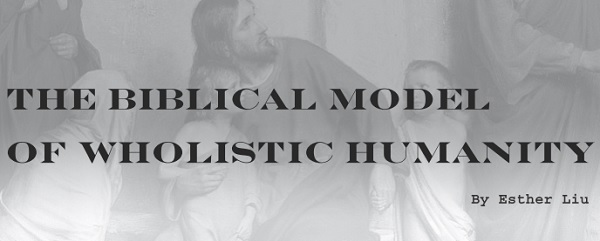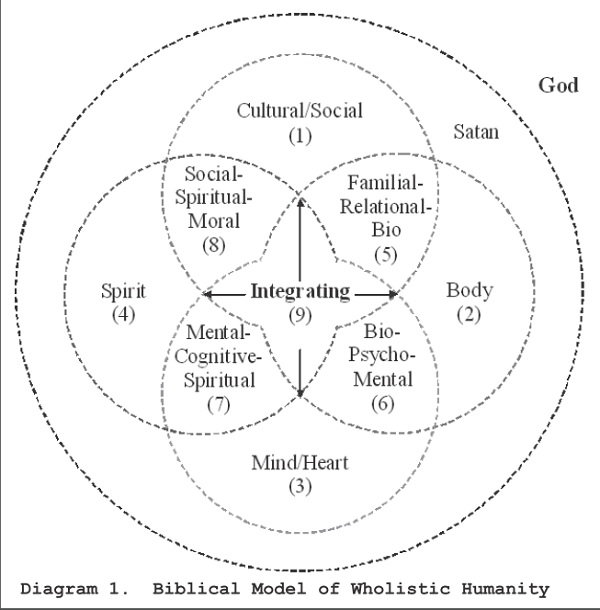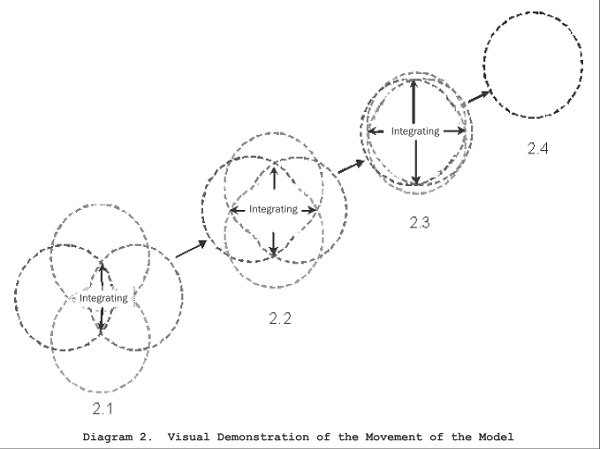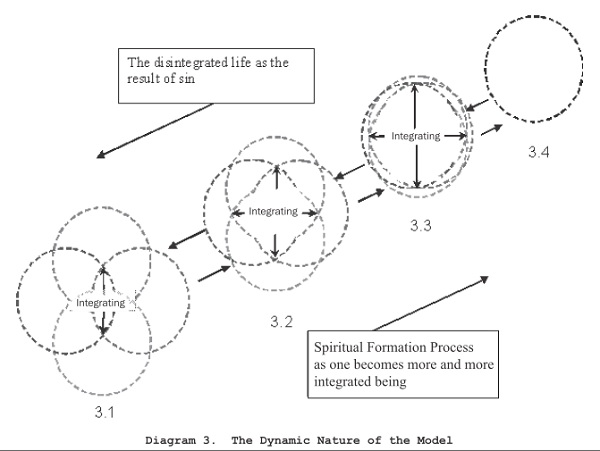The Biblical Model of Wholistic Humanity
Esther Liu

In the last four articles, I talked and reflected about the history of Chinese churches in North America, the problems and issues that haunted us, several possible contributing factors toward those problem and issues, and started laying the biblical foundation for an effective solution. By studying Jesus’ humanity, I pray that we find hope in building and shaping our own true humanity in Christ.
Like most people living in the 21st century USA, I find it is very helpful to be able to see as well as talk, read and think about different things. Therefore, the following is a visual model of a wholistic humanity based on the previous study of Jesus’ life. The four aspects of humanity are presented in four different colored circles (labeled 1 to 4). The purpose is not to separate them, but to differentiate them for discussion purposes only.

The four circles have neither beginning nor end, and each is connected to the other in a continuous line to emphasize their connectedness and wholeness; not their separateness. The four circles are also equal in size to demonstrate that all four aspects of humanity are essential and equally important. The overlapping of the four circles depicts the interaction (labeled 5-8) and the total integration (the center, labeled 9) of the four aspects. The dotted lines used in the model signify that the four aspects are openly and continuously acting and interacting, firstly with each other, and secondly with their environments, with God and Satan acting as two major influences. Lastly, they are being influenced and acted upon by the environment. Satan might be the ruler and authority of this dark world and of the spiritual forces of evil in the heavenly realm (Eph 6:10-12), but God is the ultimate King and Ruler of all.
To better understand the model, the following definitions of each of the four aspects of humanity are included. The body includes the physical body, sexuality and gender, physical health and growth, illness, aging, and death. Mind/heart encompasses reasoning, learning, logic, and knowledge; it also includes emotions: feelings, love/caring, suffering, compassion, and personalities; additionally, it includes morals and sense of right or wrong, justice, conscience, characters, commitments, will, creativity (in art, poetry, music, drama), and wisdom or the ability to integrate them all. Culture/social includes family, community, society, and cultural influence.
The Spirit (pneuma) is used to mean the human spirit, human insofar as he or she belongs to the spiritual realm and interacts with the spiritual realm. “The spirit of the man is that aspect of the man through which God most immediately encounters him, that dimension of the whole human wherein and whereby he or she is most immediately open and responsive to God, that area of human awareness most sensitive to matters of the spiritual realm.” Examples would be the deep desire inherent in human nature for eternal things or the longing to have a relationship with God Eternal, or childlike wonder, or the desire to worship, or to search for the meaning of life. Prayer (talking and listening to God), meditation, and spiritual growth/sickness could be all included in this area.
The word “soul” (psyche) is not used in the diagram since, most of the time in Scripture, soul stands for the whole person, the entire being as David Augsburger used it when he talked about wholistic pastoral care (as “soul making”). Dallas Willard used it in his lecture in a very similar way. He used the analogy of the control knob on a washing machine that coordinates and organizes all the different aspects or parts of the washing machine to ensure the smooth working of the whole machine. “Psyche,” therefore, is defined as, first, “that which makes a body…into a living being…in other words, that which is alive.” In the New Testament, soul is the seat of life or life itself, such as in Luke 17:33, “whoever would save his life (psyche) will lose it; and whoever loses his life for my sake…will save it.” “Psyche embraces the whole natural being and life of man for which he concerns himself and of which he takes constant care.” 5 Second, “psyche is the sensitive part of the life of the ego, the seat of the emotions, of love, of longing, and of gladness…it is the uniting factor for the inner power of man.” It is, therefore, more than merely the “life” but “the whole man, with all that he believes, hopes and strives for.” Brown also points out that in Luke 1:46, “soul is used in parallel with spirit. Both have here the meaning of the whole inner man, in contrast to the outward aspect of lips and speech. Above all, soul spoken here…is the seat of the religious life and of man’s relationship to God.”
Another way to demonstrate the inseparable characteristics of the four aspects of humanity is to study the New Testament Greek translation of Deuteronomy 6:5 and the similar passages in the New Testament (for the usage of “heart, soul, strength, spirit” and the conjunction “and”). Each of the four aspects, heart, soul, strength, and mind, has its own definite article, meaning they are indeed four different aspects. The Sharp’s rule 10 clearly states that “if two substantives are connected by kai and both have the article, they refer to different persons or things...; if the first has an article and the second does not, the second refers to the same person or thing as the first....”
However, the three Greek coordinating conjunctions, “ands,” that connect them all, also indicate that the four aspects are ONE fully connected and integrated unit. As in a quartet, four people are playing the same musical number, but using four different instruments. Sometimes they might be playing the same notes, sometimes not. Sometimes one instrument stops playing, and others go on. Sometimes one is playing more softly than the others, sometimes more strongly. All the time, though, each musician listens to and interacts with the others. Only when all four parts are melded and integrated with each other in complete harmony can the quartet bring out the true beauty, riches, and fullness of that particular piece of music!
In Jesus’ life, ministry, his interaction with people, even in his death and resurrection, he demonstrated again and again that he functioned as a totally integrated human being and that he related to people and addressed their common human conditions in an integrated and wholistic way. Out of who he is (his being) and out of his completeness and wholeness, he lived, taught, and related to others and God.

Diagram 2 is an attempt to show the movement of integration. The more the four arrows in the middle were pushed outward, the more the four circles overlapped, and the more the area of “integrating” of the different aspects increases (movement from 2.1 until to the very outline of the circle in 2.3). When the four circles are fully overlapping (when the four aspects fully integrated with each other), the model becomes “one circle” in 2.4. Therefore, 2.4 shows a four-times twisted and collapsed cylinder, similar to a compressed, modified “Moebius Strip” which is a one-sided non-orientable surface.
Circle 2.4 represents Jesus, who indeed is a multi-dimensional, dynamic, and wholistic being! His life is like a world class quartet that plays the most beautiful, rich, and heavenly music!

Another way to look at the movement of the integrating process is shown in diagram 3. When God created man and woman in His own image and likeness, God said “it is good.” In Diagram 3, they would be at 3.4, wholistic beings and fully integrated.
However, after man and woman willfully chose to disobey God, the relationship between God and the man and woman and the relationship between the man and the woman were broken. The land was cursed, Adam and Eve were physically chased out of the garden, spiritually separated from God, emotionally battered, and now one ruled over the other. All who were descended from them were to live in the consequences of their sins.
In the stories of human beings unfolded in the rest of the Bible, the disintegration of the being is evident (moving from 3.4 to 3.1). Languages and cultures became barriers and reasons to abuse, discriminate, and kill those who were different. Evolution proclaimed that human beings were just physical beings, evolving from nothing, and that life was all about survival and reproduction. Spiritual death brought moral decay. Teachers, coaches, youth workers, politicians, priests, and pastors are caught using drugs, molesting children, and having affairs. The excuse is often used, “as long as they are doing their job” (such was the case of the president of the most powerful country in this world, the United States of America). The recent waves of “holistic body, soul and mind” integration of all kinds, from music to medical practices to food and nutrition to brain mapping, only try to seek the control, but not the truth of humanity.
The Good News is that Jesus’ salvation could change the downward and disintegrated life to the upward and integrating life through the process of spiritual formation. Christian growth is an ongoing, unending, and dynamic process. It is not a project with a deadline, but more of a journey to be taken with fellow travelers. In our spiritual journey, the more we are aware of our own multi-dimensional beings, the more we are able to surrender them all to God. The more we could live as whole beings, the more we can relate to our fellow travelers as such, and, at the end, all could become more like Christ (moving from Diagram 3.1 to 3.4). This model, therefore, will be helpful in presenting not only the concept of wholistic humanity, but also in demon-strating the dynamic and the developmental nature of it.
Jesus, the Son of God and a Jewish man, became the friend and savior for the oppressed, the widowed, the poor, the sinners, and the sick and rejected. In his short thirty-plus years of life and ministry, he simply turned our understanding about God, who we are as human beings, and our relationships with each other and with God completely upside down and inside out.
He ate, drank, danced (maybe), cried, and laughed and taught lessons about God with power and authority that challenged, rebuked, and moved. He spoke to people’s hearts and souls and about food and God in the same sentence. He healed physical illness, along with the deeper pain and hurt buried with it. He loved and was loved and was also scolded, ridiculed, betrayed, beaten, and killed. In his life and his death, he brought reconciliation between God and men, between men and women, between the powerful and the powerless, between the insiders and the outsiders. In his resurrection, he showed us the hope of eternity. In other words, through his being, his life, his death, and his resurrection, as who he was, Jesus taught us and set an example before us about who we really are in God and so how we should live and hope as such people.
The “as---so” model of spirituality is derived from passages such as the following: “As Christ accepted us, so you should accept one another,” (Rom 15:7), “Just as Christ was raised from the dead, [so] we too may live a new life,” (Rom 6:4), “[So] Forgive as the Lord forgave you,” (Col 3:13). Through studying Jesus’ life, Jesus demonstrated a very different way, a wholistic and complete way, to live, love, forgive, accept, teach, disciple, and bring healing for us. The next question is then, how shall we, as followers of Christ now live, love, relate, accept, forgive, teach, and disciple as he has exemplified for us in the Bible? If we truly understand this biblical model, we surely could not teach and disciple others as if they are simple, one dimensional, and stagnant beings. We ought to plan our curriculum, conduct our counseling sessions, prepare our sermons, and carry on our discipleship training in a very different way that speaks to people’s whole beings as Jesus has amply shown us in Luke. May the Truth set us free (inward), transform our relationships with each other (outward) and with God (upward), and most importantly, enable us to live in obedience to walk and follow in the way of Jesus (forward).
In the next few articles, I would like to present a way to start you on the journey toward wholeness (shalom/peace). The whole spiritual formation curriculum is based upon the biblical model of Jesus’ humanity and you are invited to use it, experience it, struggle with it, and turn it upside down and around. I am a firm believer in changing one little thing at a time and one person at a time. If we all are willing to start moving one step closer to Christ-likeness, however small that step is, our lives will not be the same. Our family will not be the same. Our churches will not be the same. The world surrounding us will not be the same! Please come!
References
1 Model modified from David Augsburger’s “developmental model,” in lecture notes from “Pastoral Care as Soul Making,” Fuller Theological Seminary, 2000.
2 Brown, The New International Dictionary of New Testament Theology, vol. 3, 693-694.
3 David’s Augsburger’s class lecture from “Pastoral Care as Soul Making,” Summer, 2000 and Dallas Willard’s class “Spirituality and Ministry,” Spring 2006. One of the quotations that Augsburger used in his lecture was by a physicist name Paul Davies: “What stuff is the soul made of? The question is as meaningless as asking what stuff citizenship or Wednesday are made of. The soul is the holistic concept. It is not made of stuff at all. Where is the soul located? Nowhere. To talk of the soul as being in a place is as misconceived as trying to locate the number seven or Beethoven’s Fifth Symphony. Such concepts are not in space at all.” Willard also uses the analogy of a cell-phone in his book with Randy Frazee, Renovation of the Heart (Colorado Springs: Think, 2005), 39, and more discussion of soul on pages 196-215.
4 Ibid., 680.
5 Ibid., 682-683.
6 Ibid., 680.
7 Ibid., 683.
8 Ibid., 683-684.
9 Matt 22:37, Luke 10:27, and Mark 12:30 said “Love the Lord your God with all your heart and with all your soul and with all your strength and with all your mind.”
10 James Brooks and Carlton L. Winbery, Syntax of New Testament Greek (Lanham, MD: University Press of America, 1979), 70.
11 Eugene Van Ness Goetchius, The Language of the New Testament (New York: Charles Scribner’s Sons, 1965), 244. “kai...kai means both...and or not only...but also....”
12 Eric Weisstein, “Math Resources” [Information online] (Wolfram Research, updated periodically, accessed 4 June 2007), 1; available from Mathworld.wolfram.com; Internet.
13 Volf’s book Exclusion and Embrace is a great book to read further into this area.
14 One simple example: pornography, seeing women/children as pieces of meat, basically, is a big, if not the biggest, business on the internet. Donna Rice Hughes, “Kid’s Online: Protecting Your Children in Cyberspace” [Information online] (Enough is Enough, 2006, accessed 4 June 2007); available from www.enough.org; Internet.

